Holidays pose the perfect opportunity for brands to connect with their customers and delight them with a memorable experience.
Reports state that 72% of shoppers are willing to pay more for a great customer experience. 59% even recommend a brand to peers for its customer service.
By offering hassle-free services for holiday shopping, you can increase revenue and win customer loyalty. Today's article will discuss how you can deliver customers a memorable holiday shopping experience with ten easy steps.
Tips for Creating a Memorable Holiday Shopping Experience for Your Customers
- Understand your customers
- Optimize website design and navigation
- Add product search and filtering
- Add a chatbot for customer service
- Create seamless omnichannel integration
- Personalize offerings
- Focus on marketing and promotions
- Create a hassle-free checkout process
- Special online-exclusive offers
- Engage post-purchase

Custom image created in Canva
- Understand your customers
You can’t deliver a delightful holiday shopping experience if you don’t know what your customer wants. For that, collect first-party and third-party customer data and examine their preferences.
Evaluate your sales records of previous holiday seasons to get a clear insight into their purchasing habits. Consider using an AI-powered analytics tool to get accurate reports.
Segment the collected data based on the following criteria:
- Demand surge in past holiday seasons
- Cart history
- Engagement rate
- Gifting habits
Gathering customer feedback is another neat way of understanding what your customer desires during the holiday season.
Add a poll widget to your website for quick feedback collection. You can also share online surveys with your email list.
Personalization makes shopping experiences memorable. After analyzing customer data, create customer segments to tailor your services that accommodate unique holiday demands.
Consider these key demographics:
- Age
- Gender
- Location
- Ethnicity and religion
- Hobbies and interests
Accurate ICPs let you:
- Create an adaptable process that appeals to each customer segment.
- Offer better personalization with relevant recommendations, special holiday deals, and offers.
- Understand how to make your products more appealing for the holiday season.
- Optimize website design and navigation
You can’t attract holiday shoppers with a generic website design. They explore online shops for festive deals and gift ideas. Make homepage adjustments with holiday designs to be a part of the festive spirit.
It can include:
- Festive fonts and colors
- Banners with holiday slogans
- Holiday-themed visuals, etc.
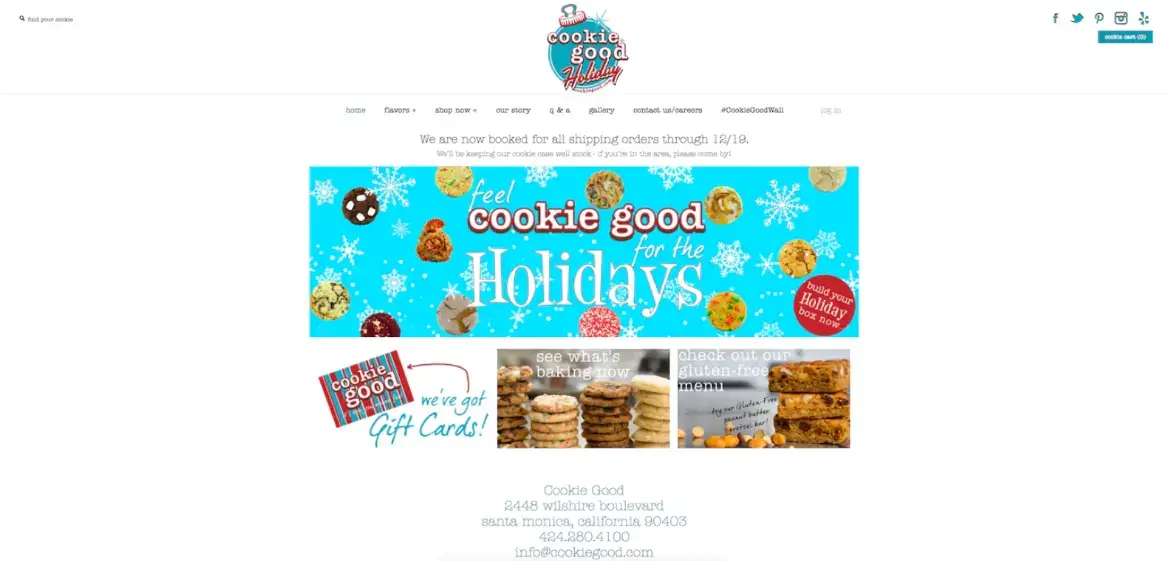
Source: Shopify
For example, Cookie Good adapts its website homepage with yearly holiday themes.
Customers can create their holiday boxes with the website’s easy navigation. They also showcase gift card options on their homepage to simplify holiday shopping for confused gifters.
Google reports show that when page load time goes from 1 second to 3 seconds, it increases the probability of bounce rate by 32%.
Optimize your page load speed to keep your visitors engaged on your site. Compress your website visuals since heavy files can prolong loading time. Reduce redirects for faster HTTP requests and response processes.
For better optimization, focus on the following additional factors:
- Run A/B testing for different holiday website designs to find the best one.
- Add additional features like a customized greetings generator.
- Include a countdown banner to create urgency.
- Ensure your website is responsive to different devices.
- Target holiday-specific keywords to drive more traffic.
- Prepare your website to handle increased holiday traffic.
- Add product search and filtering
Festive shoppers look for holiday-specific products.
Ease their journey by adding relevant product search and filtering options. Optimize your website with keywords relevant to the holidays so customers can find seasonal items without going through an entire catalog.
Adding filters lets your customers narrow their search and decide faster. You can also include pop-up gift filters to help shoppers find the right gifts for their loved ones.
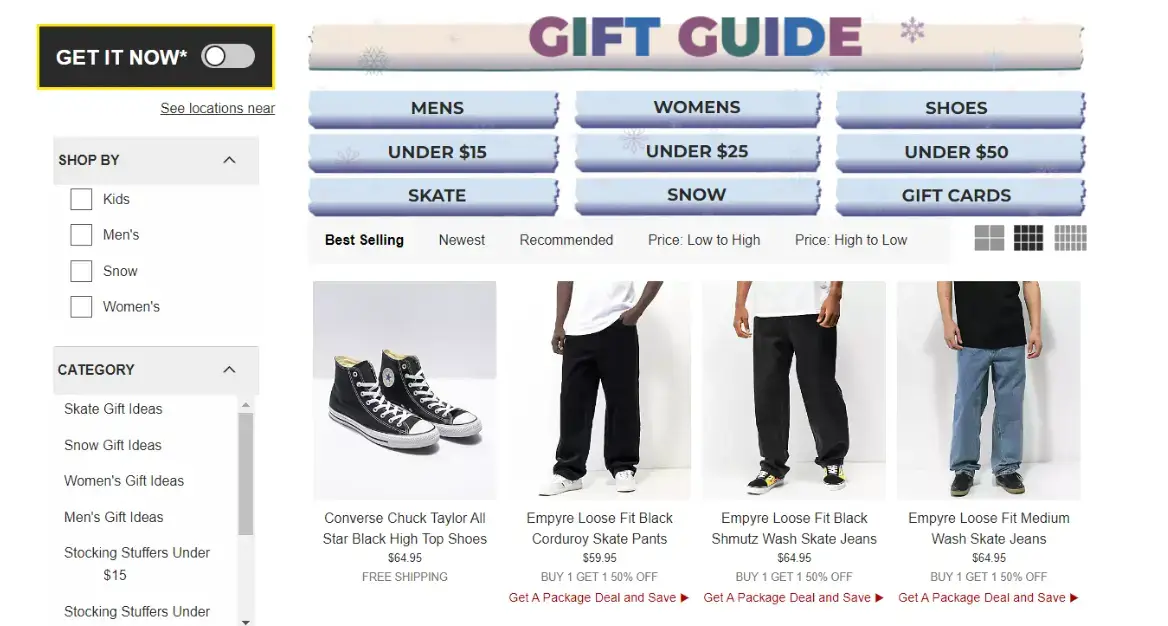
Besides product filters, Zumiez offers a holiday gift guide to help shoppers find the right presents. They showcase varied filters to suit different genders, budgets, and preferences.
Why? Most people procrastinate their holiday shopping till the very last moment.
Your product images and descriptions should also be detailed enough to let customers make an informed decision. It will avoid last-minute returns and add to their satisfaction.
- Add a chatbot for customer service
Product demand soars quickly during the holiday seasons. Assisting each customer with a personalized focus becomes difficult with a manual process.
It takes longer to resolve issues, frustrating the customer and losing their business.
Automating your chat widget with an AI-powered chatbot is the best way to speed up customer service.
Chatbots can resolve general customer queries without human intervention, keeping average waiting time to a minimum. It helps companies manage the holiday rush and deliver each customer the best possible customer service.
Moreover, reports suggest virtual assistants can cut customer support service fees by 30%. Virtual chat support systems can also collect conclusive customer data, letting you improve your services every season.
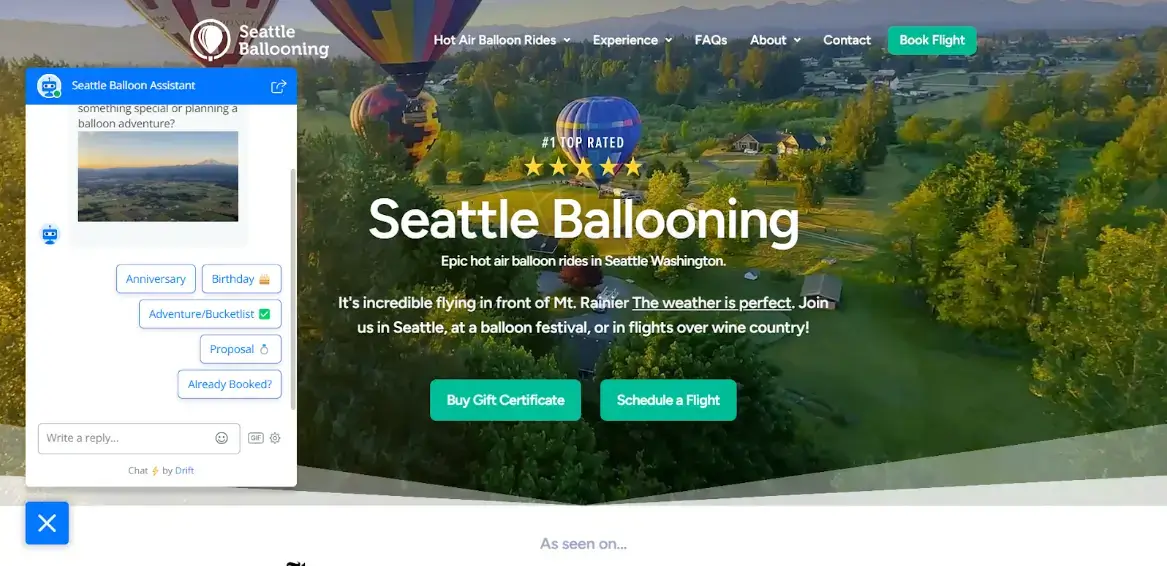
For example, Seattle Ballooning has a virtual assistant on their website. Customers can make queries, book rides, and report issues through the chatbot.
- Create seamless omnichannel integration
To elevate customer experience during the holidays, create a seamless integration of all your channels.
It lets consumers easily interact with your brand and offer convenience and flexibility beyond the limitations of traditional retail.
An omnichannel shopping experience covers multiple touchpoints, reaching a wider audience quickly. Such a quick shopping experience helps them find the right holiday items, enhancing customer satisfaction.
An omnichannel approach also empowers brands to establish credibility through social proof.
Ensure you align your brand messaging and holiday marketing strategy's tone across your online and offline stores, social media channels, and messaging apps. Collect data for every channel to examine the loopholes and make improvements.
For example, Haus Labs, a cosmetic brand, delivers exceptional omnichannel shopping by aligning its website and Instagram shop.
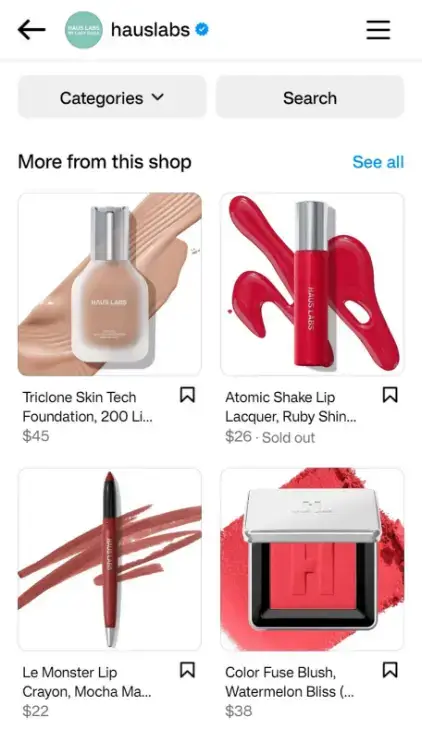
The brand showcases all its products on both channels. The tone, brand messaging, and product descriptions align perfectly, creating a seamless customer experience.
Take note: users are visually inclined on Instagram, so ensure that your Instagram logo and branding are presentable.
- Personalize offerings
Accurate personalization is the perfect method of leveraging the holiday enthusiasm of your customers. It helps you cut through the noise of competitors’ promotions and grab shoppers’ attention.
Analyze past sales records and performance metrics to tailor the customer experience. Arrange giveaways to gain new customers and boost loyalty. Offer holiday special discount codes to regular customers.
Ensure you optimize your marketing channels to inform the customers about the offers.

Send emails with personalized subject lines and strong product-specific CTAs as Fitbit does. They also provide ‘free 2-day shipping’ and ‘gift now, pay later’ options to ramp up sales.
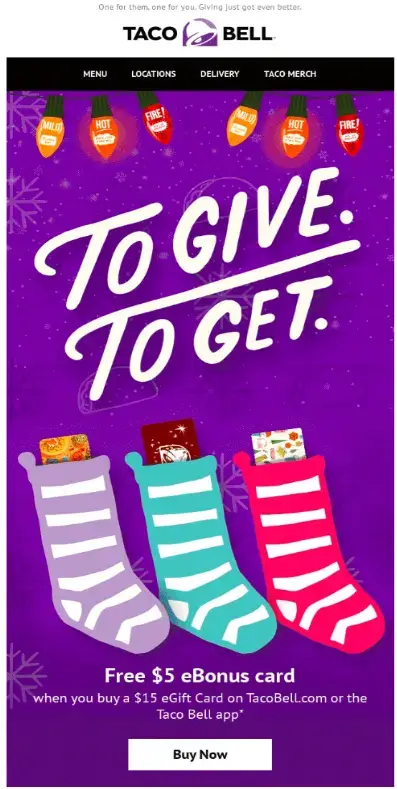
Source: HubSpot
You can also launch limited edition products for the season to engage customers. For example, Taco Bell offers $5 eBonus cards on Christmas with every $15 eGift card purchase for their holiday range.
- Focus on marketing and promotions
Now that you have put relevant offers and holiday tweaks in place, it’s time to focus on promotions.
Reach your existing customers and target audience with personalized marketing campaigns. Optimize your social media presence with targeted ads celebrating the festivities. Send emails with holiday offers, new product launches, and special discount codes.
Incorporate visual content techniques and strong CTAs into your emails. Brands can also brew holiday contests to boost engagement and pique audience interest.

Starbucks’ Red Cup Contest is an excellent example of brands using festive spirits for promotional campaigns.
- Create a hassle-free checkout process
An easy checkout process is crucial to a memorable holiday shopping experience. Analyze customers’ patent preferences and eliminate multi-step checkouts.
Offer a guest checkout option to avoid losing sales over a simple obstacle. Add a progress bar to let the customer know the steps they must take.
Use fraud detection tools and a reliable payment gateway to safeguard the process. Don’t forget to keep your checkout system up-to-date to comply with current norms.
- Special online-exclusive offers
Provide limited-time deals to boost holiday shopping enthusiasm. Add countdown pop-ups in your emails and your website. It creates a sense of urgency and might increase the average order value.
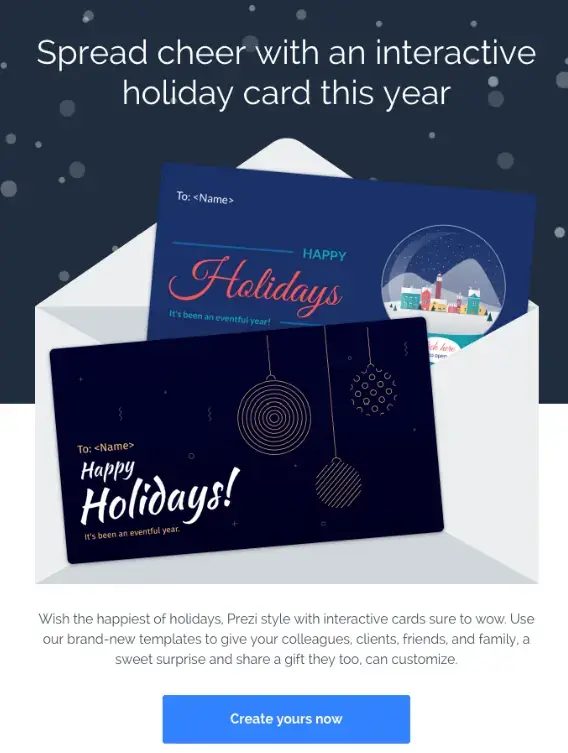
Offer free personalized packaging for online orders.
You can also offer digital gift cards for email subscribers like Prezi, so your customers’ loved ones can shop for themselves.
Instead of placing a fixed amount, let the customer choose the gift card’s value.
Run competitor analysis to get insights into what offers your rival brands are providing. Examine customer response and identify gaps.
This way, you can design online-exclusive offers that make you stand out in the holiday shopping buzz.
- Engage post-purchase
While a revenue boost is excellent for your business growth, another important goal is to boost loyalty. Here is what you can do for post-purchase engagement:
- Send personalized thank-you emails
- Share timely delivery updates
- Ask for feedback
- Set up a replenishment program
- Focus on upselling and cross-selling
- Enhance your return and refund policies
- Start loyalty programs
Chris Masantos, founder and CEO of Petlab Co., says,
“We believe that our relationship with our customers doesn't end at the point of purchase. It's just the beginning. We're committed to engaging with our customers post-purchase, ensuring their needs are met and their expectations are exceeded. After all, our customers aren't just buying a product; they're joining a community of passionate pet owners.”
We also recommend integrating an automated chargeback management tool like Chargeflow to ensure you can effectively remediate post-purchase chargebacks on autopilot.
Experts have said that post-purchase chargebacks account for 0.47% of total service provider income.
Conclusion
The holiday season is the perfect opportunity to gain new customers and enhance relationships with existing ones.
Ensure you examine essential past and current holiday season metrics and improve your digital marketing strategies accordingly.
Use proper automation tools to improve efficiency and keep all your channels aligned. Creating a timeline is vital to enable you to effect changes and monitor progress properly.
With the proper marketing techniques and effective customer relationship management, you facilitate business growth through a memorable holiday shopping experience for your customers.
Author BioMehdi Hussen is a SaaS marketing and organic growth consultant. He helps SaaS businesses drive organic growth and customer acquisition through SEO and data-driven content marketing strategies. Mehdi spends his spare time musing about startup growth strategies, personal productivity, and remote work. Connect with him through Twitter or LinkedIn.
|




